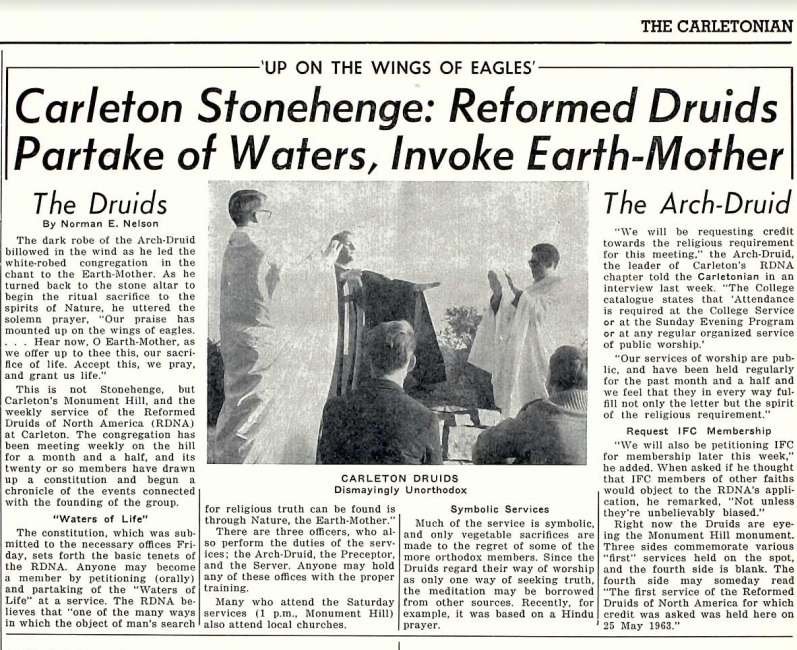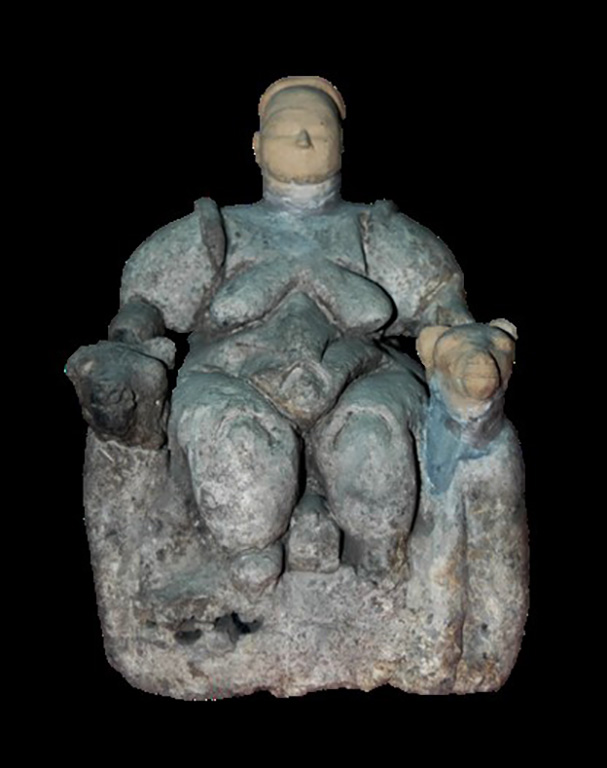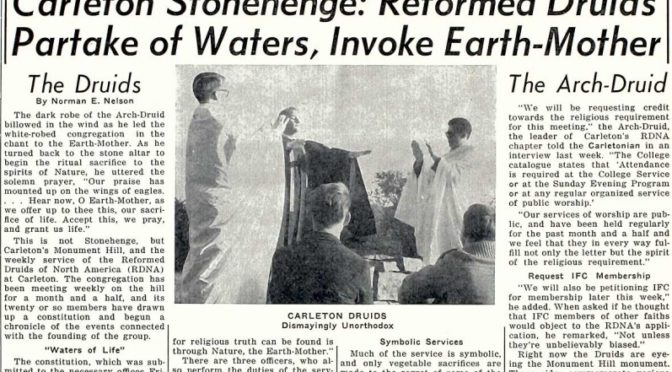[Our archivist, a self-described "kook," has a strong interest in consciousness expansion and a belief that our world's new technologies need to be integrated with new mental and spiritual techniques. In this, she is not alone. New Age religions have been popping up all over the place as the post-WW2 generation of young adults tries to make sense of our regimented world. She returns to writing to cover one of the latest spiritual organizations. Note, this article is for informational purposes only, and should not be considered an endorsement…unless it's your kind of kookery, of course!]

by Erica Frank
Like many private colleges, Carleton College in Minnesota requires that students regularly attend religious services. They don't specify which religion, expecting that Protestants, Catholics, Jews, and Muslims will each worship in their own way, but they expect the worship to conform to conventional flavors. Earlier this year, in May, a group of students at Carleton found a creative way around this directive: the students recently announced that they are now druids, and that they have been holding worship services at a stone altar outdoors rather than in any of the churches near campus.

Not much is known about the historical druids of Britain, who were suppressed by the Romans until the older religion was either destroyed or went so far into hiding that it faded into folklore. What we know of them mostly comes from Latin and Gaelic writers almost two thousand years ago, reporting that druids served as holy men, doctors, judges, and educators. (They were also reported to be sorcerers, shape-changers, and weather-witches; sorting fact from rumor is difficult.) They were priests of a pre-Christian religion that venerated nature; while they did not build Stonehenge, they are believed to be the spiritual heirs of those who did.
Taking inspiration from the ancient druids, some students are calling themselves the "Reformed Druids of North America." They have rejected religious orthodoxy in favor of nature-focused spirituality. They insist that their religious ceremonies involve wearing long robes and making sacrifices (of vegetables) to the Earth-Mother… and drinking whiskey, which is derived from grain and is therefore one of the holy gifts of nature.
They outlined the two tenets of their religion:
1. North American Reformed Druids believe that one of the many ways in which the object of man's search for religious truth can be found is through Nature, the Earth-Mother.
2. North American Reformed Druids believe that Nature, being one of the primary concerns in man's life and struggle, and being one of the Objects of Creation, is important to man’s spiritual quests.
Canny readers may notice that these two statements can be rephrased as:
1. Religion is in nature.
2. Nature is religious.
While that's a bit simplistic, it would be hard to argue that there is no truth in the two statements, nor that countless religions have not included similar concepts.
Their services draw from several religious traditions, and membership in their church is available to anyone who asks and partakes of the "Waters of Life" – a phrase which they may have borrowed from Heinlein's recent Hugo winner, Stranger in a Strange Land, although similar concepts exist in many religions. The concept of "water-brotherhood" has appeared among some students; these students aren't claiming to follow Heinlein's fictional religion, but may have been inspired by parts of it.
Their mention of the Earth-Mother may have been inspired by the recent explorations of Catal Huyuk, a prehistoric settlement in Turkey. The site was discovered in 1961, and is still being excavated. James Mellaart's discovery of the Seated Woman sculpture, showing a regal image flanked by lionesses, is widely understood to indicate a paleolithic matriarchal culture worshiping a mother-goddess.

These discoveries match what Gerald Gardner outlined in his 1954 book, Witchcraft Today: that the Stone Age religion worshipped the Great Mother, and that this "Old Religion" is being revived in the modern era. While Gardner's focus is on the "witchcraft religion" in England, several groups inspired by ancient religions have begun to make an appearance in the US, including the Carleton College druids.
Some suspect that the druid group is a prank, nothing more than a way to get out of attending stuffy church services. Instead of listening to a preacher talk about sin, they have a picnic on the lawn, with some robes and chanting to the Earth-Mother to make it qualify as a religious service. If it is just a way to dodge the rules, it is an effective test of the administration's tolerance and adherence to its own policies; since the requirement to attend services doesn't specify religion, there is no way to ban these "services" without declaring that this is not, in fact, a religion.
Their new Arch-Druid said, "Our services of worship are public, and have been held regularly for the past month and a half and we feel that they in every way fulfill not only the letter but the spirit of the religious requirement." The students have been holding public services attended by dozens of people, and their chants and prayers seem to be as spiritual as those of any mainstream faith.
It will be interesting to see what these druids do in the future. The services have started up again this school year, and if the attendees have found some real spiritual value in their "druid religion," it may have some real staying power.



Interesting article. I do suspect this is more of a way of testing the requirement for mandatory attendance of religious services than anything else.
The novel "Sign of the Labrys" by Margaret St. Clair (who also writes as Idris Seabright), published just last month, includes themes relating to this kind of matriarchal nature worship.
I keep forgetting to sign my name to these things.
How incredibly timely. I was reading that today!
There was a lot of this kind of messing around with University administrators. For example, https://en.wikipedia.org/wiki/Keith_Henson#Druid_prank
"Henson was known at the University of Arizona as one of the founders of the Druid Student Center, where a campus humor newspaper, The Frumious Bandersnatch was published in the late 1960s. He later cited an incident that occurred in his student days as a good example of memetic replication. When asked to fill in a form that required him to disclose his religious affiliations he wrote Druid. His prank was soon noticed by other students and before long almost 20% of the student body had registered themselves as Reform Druids, Orthodox Druids, Members of the Church of the nth Druid, Zen Druids, Latter-Day Druids and so on. The university was forced to remove the religious affiliation question, breaking the chain of replication and variation.[5]"
I can date the time I wrote Druid to the spring semester of 1961. (The previous semester I wrote MYOB for mind your own business.)
Best wishes,
Keith
All hail the great and powerful MYOB!
And thank you for your letter, Keith!